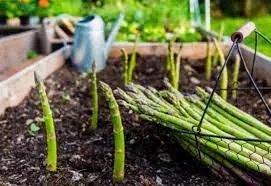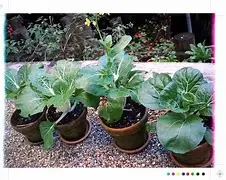How To Grow Amazing Asparagus


To grow amazing asparagus takes 2-3 years. This hardy perennial takes a while to establish so why not get started today? You can grow asparagus in a container if you provide the right conditions such as warm well-cultivated soil, a container at least 18″ deep, and at least 8 hours of sunshine. Most gardeners start with crowns to shorten the growing time but most container-grown asparagus, once established, only produces for 1-2 years. However, you can follow these instructions to plant crowns in their own bed to have 10 years of asparagus.
What Type Of Soil to Grow Amazing Asparagus?
Asparagus likes warm soil in zones 4-8 in the USA. The soil is well cultivated to grow it successfully with a Ph between 6.5 -7.0. The soil mix should be a good quality potting soil mixed with aged compost. If in a container, make sure there are plenty of holes in the bottom for drainage.
How To Plant And Care For Asparagus?
To grow asparagus from seeds takes patience but there are advantages. Asparagus seeds don’t have the transplant trauma that nursery roots do. You can buy a packet of asparagus for the same price as one asparagus crown. Finally, most seed-grown asparagus out-produce the transplanted roots.
Growing Asparagus From Seeds
Start seeds indoors in late February or early March. Sow a single seed in a peat pot in a sunny window. It’s best if the soil maintains a temperature of 77ºF so you may want to invest in a heat mat like this one from Amazon. When the seed sprouts, reduce the temperature to 60 to 70ºF. When they are 1 foot tall, plant your seedlings in a pot 4-6 inches deep in a well-cultivated compost-rich soil. The soil should contain a 10-10-10 fertilizer.
Once shoots appear around the plantings, add a fertilizer with higher nitrogen content. Test your soil every year to make sure there is not a phosphorus build-up in the soil. Asparagus doesn’t like a lot of phosphorus so use fertilizer without one if phosphorous is high: 30-0-10. Take asparagus outside when all danger of frost has gone and place in a sunny location. Grow asparagus in a place with at least 8 hours of sunlight per day.
It Takes Patience To Grow Asparagus
After planting, shoots should appear around the plant within a couple of weeks. Let the plants grow. Mulch around the plants to reduce weeds and to maintain moist soil. Leave the containers outdoors through the fall and winter. You can cover the pots with bubble wrap to prevent breakage or keep them in the garage or shed during the winter months. The plants need two seasons to establish themselves well. Asparagus shoots will peek out again when the sun warms them up in the spring. In the third year, you can start harvesting but make sure to leave some asparagus so they can grow ferns. Stop harvesting around mid-June. The ferns will allow the asparagus to spread before going dormant for a larger harvest next year.
Plant and Grow Asparagus From Seeds or Transplant?
As mentioned above, you can grow asparagus from seeds or by transplanting nursery-bought crowns. Asparagus started from seeds is healthier but takes 3 years until harvest. Crowns are expensive and can be harvested the 2nd year. The best solution is to start a couple of crowns for a season or two while planting seeds at the same time. Then you will have asparagus while waiting for the seed babies.
Another alternative, you can even grow Asparagus from store-bought asparagus by cutting the spears in half, soaking in compost tea (a mix of compost and warm water), and planting them deep directly into the soil on a hot day. Water well, mulch, and pray they take root.
Pests And Diseases When You Grow Asparagus
When you grow asparagus the main problem is water. Fungi, water mold, and viruses are common to asparagus. Scientists have found that bio fungicides work best on most fungi. Damage is usually caused by long periods of rain and wet conditions. This makes growing asparagus in a container, that can be moved out of downpours, a plus. Also, having well-drained soil is a must.
Asparagus is also in danger from viruses. These can be particularly cruel to young plants. Aphids sometimes transmit viruses so plant marigolds around the bed to deter the aphids.
Companion Plants of Asparagus
The best companions for asparagus are tomato plants because the asparagus gets rid of nematodes that attack tomatoes and tomatoes repel asparagus beetles. Marigolds are good to get rid of aphids on both plants. Sage, thyme, dill, and asters can also be beneficial to your asparagus plants.
Harvesting Asparagus
You may be tempted to harvest some young asparagus spears the 2nd year you plant them from seed. Stop yourself. The asparagus are gaining strength and energy from the entire colony. They will be stronger and hardier if you resist temptation and harvest the third season.
Also, once you begin harvesting, make sure to stop harvesting by mid-June so the asparagus stalks (that we eat) can produce leaves or ferns. These ferns store up energy in the root stalks for the coming winter. They are critical for asparagus to survive to the next season.
Asparagus Recipe

I have never grown asparagus before now but I am definitely trying to grow asparagus now. When researching this article, I found Food & Wine’s article on 25 Asparagus Recipes including my favorite, Asparagus with Almonds and Garlic. The link takes you to their website. I hope you try the recipe and let me know how you like it.
Conclusion
To grow asparagus into a bed of hardy spearheads takes time and patience. I think we all have the time nowadays, the patience is not so hard since, once planted, you only need to water and check the soil Ph. I hope you have good luck growing asparagus. Let me know if you’ve tried in the comments below.
